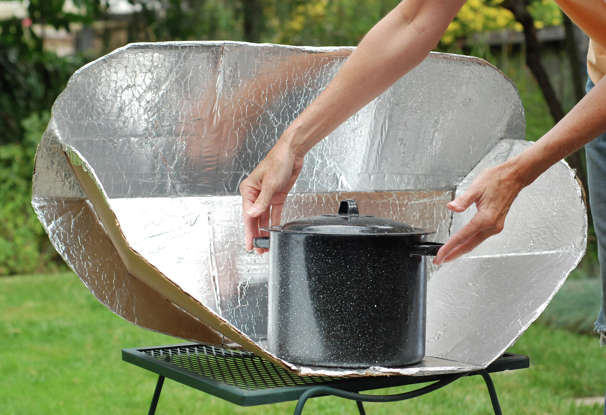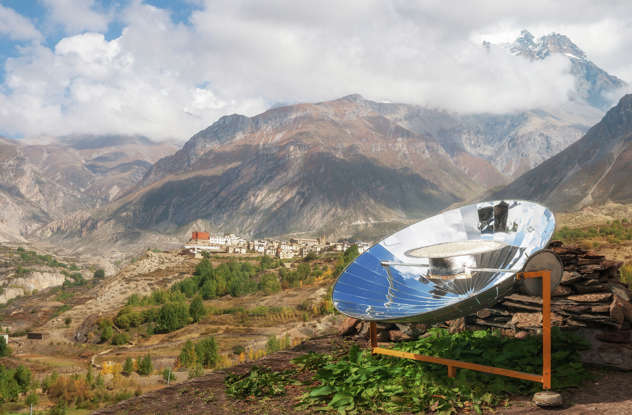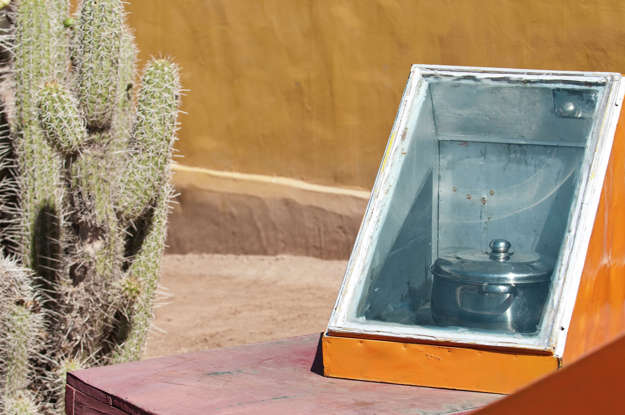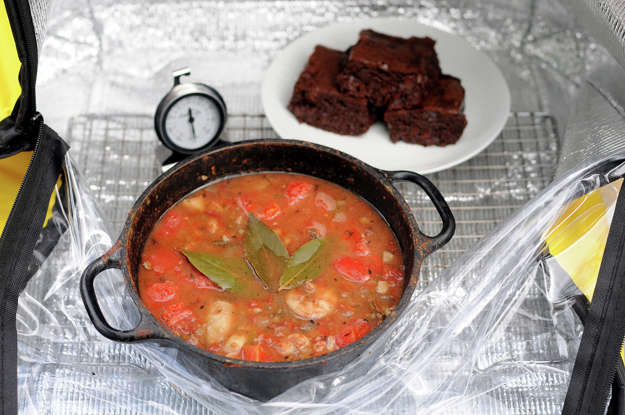New Mars Forums
You are not logged in.
- Topics: Active | Unanswered
Announcement
#1 2023-12-28 18:55:48
- SpaceNut
- Administrator
- From: New Hampshire
- Registered: 2004-07-22
- Posts: 30,016
Solar cooking reflected heat
Texas heat: Here's how to cook safely with solar power, plus 2 recipes that pass the test
We've all seen the videos by now. It's triple-digits hot outside, and someone gets the bright idea to to fry an egg on the sidewalk or the hood of their car. But just because you can sizzle a few hot dogs on your dashboard doesn't mean you should.
Food poisoning is real, y'all. And stunts like that, while certainly a fun way to demonstrate just how much hotter San Antonio is than the rest of the country, are an exceedingly easy way to subject yourself to several kinds of nasty bacteria and possibly a trip to the doctor.
Fortunately, there is a safe way to cook with nothing more than a few strong sunbeams, but you'll need some special equipment. A solar cooker, to be specific. When deployed correctly, these devices can achieve and hold temperatures of 200 degrees or more — well above the 40 to 140 degree "danger zone" the U.S. Department of Agriculture says is prime real estate for bacteria to move in and multiply.
Solar cookers come in a wide range of shapes and sizes, but all share one commonality: They harness the power of the sun to cook a meal without help from smoldering coals, a gas flame or any other source of energy.
And that's more than a cool party trick. According to the U.S. Library of Congress, "many organizations are introducing solar cooking to the world's less developed regions to prevent further deforestation in fuel-starved areas. They hope also to liberate the women and their children who must spend their days trying to gather fuel instead of working or going to school."
Camping recipe: Miranda Lambert cooks an omelet in a freezer bag, but should you?
Here in San Antonio, we have ideal weather conditions to use a solar cooker several months out of the year. They're a handy sidekick on a camping trip and dependable backup in the event of a power outage. Some models are made of foldable material and tuck neatly into a backpack, while others are more elaborate permanent installations that look like an extra-sparkly satellite dish.
There's a lively online community of solar cooking enthusiasts on sites such as fandom.com and reddit.com. Some users of those sites share DIY construction plans for sophisticated solar ovens that can roast a whole chicken with ease, while others are eager to share their latest recipes. For the less handy of us out there, several varieties of solar cookers can be purchased online.I've spent the past week test-driving the most budget-friendly solar cooker I could find — a bright yellow model made by Energy Wise, available for about $50 at amazon.com. The compact device fits in a small carrying tote and takes about a minute to set up. Under the best conditions, typically the most miserable time of day between 2 and 4 p.m., temperatures inside the well-insulated cooker hit just above 200 degrees.
While it wasn't quite hot enough to boil water — don't ask about the botched attempt to make a spicy batch of rice pilaf — the Energy Wise solar cooker gave more than enough heat to bake a pan of brownies and safely cook a pot of cioppino-inspired seafood stew loaded with tomatoes, cod and shrimp.
The first thing to keep in mind with a solar cooker is that it's going to be a long, slow process. Give yourself plenty of time to let the oven and any pots or pans you may be using heat up, at least 45 minutes in the Energy Wise case. And your food will take even longer. The fish stew was done after roughly three hours, and the brownies took nearly four hours to properly set and develop a crust.
Always use a probe-style thermometer to make sure any eggs, meat, poultry seafood or other ingredients that require safe handling have reached the USDA recommended temperature before serving.
Chiminea cooking: How to cook in a chiminea with 3 recipes
And this isn't set-it-and-forget-it cooking. The angle of the sun is constantly changing, meaning you'll have to keep an eye on your cooker to ensure it's absorbing as much solar power as possible. Depending on the shade from buildings or trees, you could find yourself repositioning the cooker every 20 to 30 minutes.
But this slow-and-steady approach to cooking has benefits that go well beyond preparing the day's feast, even if it takes a little extra time.
"Approximately 2.4 billion people cook over wood, animal waste or charcoal fires. They breathe in smoke and soot for hours every day. And more rely on expensive, unsustainable fossil fuels," according to the nonprofit organization Solar Cookers International. "People who harness free solar energy for cooking breathe cleaner air, drink safe water, and preserve the environment."
If you're ready to spend some time in the sun and get a little cooking done along the way, try either of these recipes that have been fine-tuned for a solar cooker.
Solar Cooker Fish Stew
This bright and herby stew is loosely modeled after the classic Italian seafood stew cioppino. For a taste closer to the real deal, add a half cup of white wine to the broth, but bear in mind some of the alcohol won't evaporate out at the lower temperatures of a solar cooker.1/2 cup finely chopped onion
1/2 cup finely chopped celery
1/2 cup finely chopped bell pepper
2 cloves garlic, minced
Salt and pepper, to taste
1 (14-ounce) can diced tomatoes
1 (8-ounce) can tomato sauce
2 cups vegetable stock
3-4 bay leaves
3-4 sprigs fresh thyme sprigs
1 pound cod fillet, cut into 1-inch cubes
1 pound shrimp, peeled and deveinedInstructions: Position your solar cooker in direct sunlight and place a covered cast-iron Dutch oven and an oven thermometer on a small rack inside. Close the oven and let the oven and pot heat until at least 175 degrees, about 45 minutes. When heated, add the onion, celery, bell pepper, garlic, salt and pepper, tomatoes, tomato sauce, vegetable stock, bay leaves and whole thyme sprigs to the pot. Stir to combine, cover the pot and close the cooker. Let the stew heat in the cooker until it reaches 175 degrees, which could take up to 2 hours or more depending on the weather. When the stew is hot, add the fish and shrimp, and stir to combine. Cover the pot, close the cooker, and allow it to heat until the fish is cooked through and the contents of the pot are at least at 150 degrees, which should take about 1 hour, depending on weather. Remove the bay leaves and thyme sprigs before serving.
Makes 4 servings
Paul Stephen, Express-News Taste writer
Fire-pit cooking: How to cook over your fire pit
Solar Cooker Brownies
These dense, fudgy brownies are the perfect way to end a long and hot day under the pounding sun of San Antonio.1 cup butter, room temperature
2 cups sugar
1 teaspoon vanilla
4 eggs
2 cups all-purpose flour
2/3 cup cocoa powder
1/2 teaspoon baking powder
1/2 teaspoon salt
1/2 cup chocolate chips or chopped walnuts (optional)
Instructions: Mix the butter, sugar and vanilla together in a large bowl. Add the eggs and mix until smooth. Add the flour, cocoa, baking powder, salt and chocolate chips or walnuts, if using. Gently fold the ingredients together until just combined, being careful to not overmix the batter. Pour the brownie batter into an 8-by-8-inch baking pan lined with parchment paper. Place the pan in a heated solar cooker and cook until the brownies are set, 1-2 hours depending on weather.Makes 8 servings
Offline
Like button can go here
#2 2023-12-28 19:21:10
- tahanson43206
- Moderator
- Registered: 2018-04-27
- Posts: 23,617
Re: Solar cooking reflected heat
For SpaceNut re new topic!
Best wishes for success with this!
Turning the cooker by hand to follow the Sun seems reasonable for a camping trip.
I'll bet that if this cooking method catches on, automatic Sun tracking turntables will show up on the market.
A family might be willing to try this cooking method if it were a "set it and forget it" situation.
For all ... links to products that support this topic would be welcome.
(th)
Offline
Like button can go here



